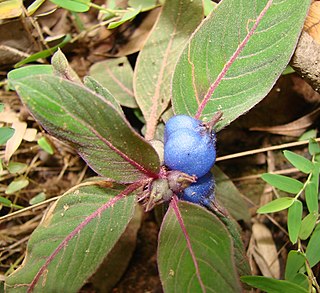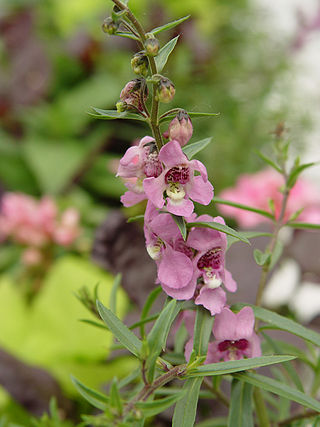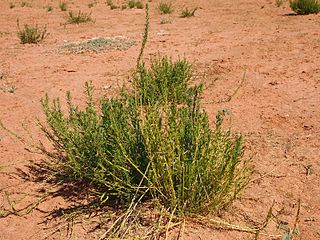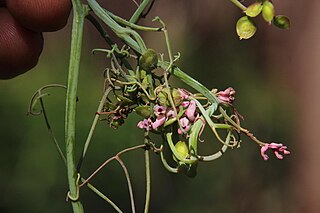
Vismia is a genus of flowering plants in the family Hypericaceae. Members of the genus are small trees and shrubs found in tropical and subtropical areas of Central America and South America. Including the countries of Belize, Bolivia, Brazil, Colombia, Costa Rica, Ecuador, El Salvador, French Guiana, Guatemala, Guyana, Honduras, Mexico, Nicaragua, Panamá, Peru, Suriname, Trinidad-Tobago and Venezuela.

Coccocypselum is a genus of flowering plants in the family Rubiaceae. It is native to Mexico, Central America, the West Indies and South America. All species of the genus Coccocypselum are herbaceous with fleshy, blue or purple fruits, and 4-petaled flowers.

Angelonia is a genus of about 30 species which occur from Mexico to Argentina and is classified in the Plantaginaceae. They are herbaceous plants occurring mainly in arid and semi-arid habitats. Most Angelonia species can be found in Northeastern Brazil in the seasonally-dry tropical forest namely Caatinga. The flowers of Angelonia are highly specialized for pollination because they have hairs in the inner corolla, which produces oils collected by oil bee pollinators, especially of the genus Centris.

Stemodia is a genus of flowering plants in the family Plantaginaceae. The genus comprises approximately 45 species of annual and perennial herbs and shrubs which are distributed through tropical and temperate regions of the Americas, sub-Saharan Africa, the Indian subcontinent, and Australia. This genus is sometimes placed in the families Scrophulariaceae or Gratiolaceae. The generic name is derived from the Latin word stemodiacra, which means "stamens with two tips." Twintip is a common name for several species.
Philcoxia is a genus of seven rare plant species in the Plantaginaceae that are endemic to Brazil and resemble terrestrial species of the genus Utricularia. The genus, formally described in 2000, consists of the species P. bahiensis, P. goiasensis, P. minensis, P. tuberosa, P. rhizomatosa, P. maranhensis and P. courensis, each of the first three named for the Brazilian state to which it is endemic. The species are characterized by subterranean stems, peltate leaves at or below the soil surface, and five-lobed calyces. Their habitat has been reported as areas of white sand in the midst of cerrado vegetation at an elevation between 800 and 1450 m. Initial descriptions of the genus included suspicions that the plethora of stalked capitate glands on the upper surfaces of leaves was an indication that these species may be carnivorous. A study published in 2007 tested P. minensis for protease activity, a typical test for the carnivorous syndrome, and could detect none. Later studies detected other digestive enzymes such as phosphatases and qualitatively assessed prey digestion and nutrient uptake, suggesting that it is a true carnivorous plant. The genus epithet honors David Philcox (1926-2003), a botanist at Kew Gardens who worked extensively in tropical Scrophulariaceae.
Philcoxia bahiensis is a rare plant species in the Plantaginaceae that is endemic to the Brazilian state of Bahia. It was first discovered collected by a local resident, Wilson Ganev, in August 1992 from the Serra do Atalho in the Piatã municipality. That collection was sent to Kew Gardens for naming. Because of its placentation, the specimen was determined to be a member of the Scrophulariaceae despite its appearance close to that of terrestrial Utricularia. Material of this specimen had been sent to Vinícius Souza, who was working on the Scrophulariaceae of Brazil. It was then formally described in 2000 as a new species.

Agalinis is a genus of about 70 species in North, Central, and South America that until recently was aligned with members of the family Scrophulariaceae. As a result of numerous molecular phylogenetic studies based on various chloroplast DNA (cpDNA) loci, it was shown to be more closely related to members of the Orobanchaceae. Agalinis species are hemiparasitic, which is a character that in part describes the Orobanchaceae.

Voyria, commonly known as ghostplants, is a genus of 20 species of herbaceous perennial plants, belonging to the family Gentianaceae. They are mostly native to warm temperate and tropical regions of the Caribbean, Central America and South America, except for V. primuloides, which is found in West and Central Africa. V. parasitica reaches as far north as the Everglades in Florida.
Francis Whittier Pennell was an American botanist best known for his studies of the Scrophulariaceae. Employed by the New York Botanical Garden and then by the Academy of Natural Sciences of Philadelphia, he carried out botanical research in both North America and South America.

Mecardonia (axilflower) is a genus of herbaceous plants in the family Plantaginaceae. 31 species have been described, of which 12 are accepted. Its distribution is predominantly in South America, and South East United States, including Florida and Alabama but may be found as far north as Virginia. (see map) Five species are found in Argentina and three in the US.
Cheilophyllum is a genus of flowering plants belonging to the family Plantaginaceae.
Curtia is a genus of flowering plants belonging to the family Gentianaceae.
Escobedia is a genus of flowering plants belonging to the family Orobanchaceae.
Encopella tenuifolia is a species of flowering plant belonging to the family Plantaginaceae. It is the sole species in genus Encopella. It is endemic to Cuba.

Discocapnos is a monotypic genus of flowering plants belonging to the family Papaveraceae. The only species in the genus is Discocapnos mundiiCham. & Schltdl. It is endemic to the Cape Provinces in South Africa.

Matayba is a genus of flowering plants belonging to the family Sapindaceae.
Sipanea is a genus of flowering plants belonging to the family Rubiaceae.
Esterhazya is a genus of flowering plants belonging to the family Orobanchaceae.
Geochorda is a monotypic genus of flowering plants belonging to the family Plantaginaceae. The only species is Geochorda glechomoides.

Buchnera is a genus of flowering plants belonging to the family Orobanchaceae. Its native range is Northern and Tropical America, Tropical and Southern Africa, Madagascar, Arabian Peninsula Tropical Asia, Australia.











